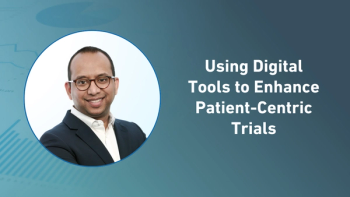- Applied Clinical Trials-10-01-2025
- Volume 34
- Issue 4
Answering the Sustainability Call: Digital Health Technologies and eCOA
Sustainability should be central to clinical trial design and considerate of how digital tools such as electronic clinical outcomes assessments can help achieve this.
In clinical trials, we essentially measure change—accurately, reproducibly, consistently, and in a way we can generalize. We strive to make well-informed decisions that account for risk, heterogeneity, and meaningfulness. We also have obligations. No-one in the clinical research community is naïve of our collective role in sustainable clinical trial execution, and yet our industry is not exactly at the vanguard of reform to nullify its environmental impact.
Current estimates for greenhouse gas (GHG) emissions from healthcare systems is around 2.4 billion tons annually, contributing to around 5% of total GHG emissions worldwide. A recent study estimated that the emissions attributable to over 350,000 registered clinical trials are equivalent to 27.5 million tons.1 These figures are not very accurate, partially due to a lack of established methodologies for measuring the carbon footprint of a clinical trial, and there being no legal or regulatory requirement to do so.
To address this, the Sustainable Markets Initiative’s Health Systems Taskforce issued an open letter2 in February 2025 signed by the CEOs of seven leading pharmaceutical companies challenging contract research organizations (CROs) to support an effort to measure the CO2 emissions arising from execution of Phase II and III trials that start in 2025. To enable this, a series of tools were developed in collaboration with the Sustainable Healthcare Coalition (SHC) via the Industry Low Carbon Clinical Trials group, including a
While the focus on CROs makes sense given their critical role in clinical trial execution, it is not only CROs needing an understanding of their environmental impact and making it measurable. Those organizations that utilize technologies such as electronic clinical outcomes assessments (eCOA) and digital health technologies (DHT) to measure the participant’s voice and experience have the same responsibility.
Acknowledging existing efforts
Environmental and human health are intrinsically linked, and progress has been achieved. Some sponsors have been forthright with their intentions, such as AstraZeneca, which published an article3 in 2023 detailing work that showed the feasibility of retrospective lifecycle assessment to appraise the carbon footprint of large clinical trials, identifying the drivers of emissions and their magnitude, and targeting zero emissions research. Johnson & Johnson have been significant contributors to the Digital Health in the Circular Economy initiative, a European Union and Commission program that seeks to reduce digital technology waste across different domains of drug development.
Tech-driven opportunities
Like every other clinical trial stakeholder, eCOA and DHT companies have their role to play in establishing innovative practices to both measure and reduce carbon emissions of their products and services.
Baselining
No standard reference exists for calculating the GHG emissions for a given clinical trial, and the available tools are regularly updated, making it difficult to keep comparable metrics. Tools for assessing the carbon emissions associated with specific activities are available, such as those generated by the SHC, but also national systems based on the GHG protocol corporate standard,4 which can help companies set a baseline and identify the main areas of emissions to support strategic decisions.
Strategy definition
These evaluations allow for meaningful actions with tangible impact to be developed, prioritized according to their impact, and their operational feasibility assessed.
Company-level policies such as waste management, paper reduction, and travel restrictions, help, but efforts to reduce the GHG emissions at the clinical trial level are crucial to building a specific, meaningful sustainability approach that eCOA and DHT providers can support.
Actioning the plan:
Despite limited evidence on this topic,5 it is acknowledged that the clinical trial GHG emissions come from various sources and can be reduced in numerous ways by eCOA and DHT providers.
- Electronic devices manufacturing and use-related emissions can be reduced by device reuse across study participants in longer trials studies or by using refurbished devices. With an average lifespan of four years for a device, refurbishing is an option for either short-term trials or for device replacement mid-trial. Increasing use of bring your own device strategies in which study participants use their own phone for the trial (with the option to switch to a provisioned device if needed) is a proven way to reduce carbon footprint.
- Logistics can be optimized with smartly grouped shipments or local device sourcing at the country level combined with minimal shipment of paper-based start-up information. eCOA/DHT providers should assess the practices of their preferred carrier, the size/source material of shipment packaging, and optimize device return procedures via soft transportation methods.
Asking third-party vendors about their sustainability ratings and certifications should be considered; while the interlocutor at the carrier company may not have details immediately, it can be defined as required for any partnership.
- Individual travel can be a significant carbon generator that can be reduced. Allowing participants to record data electronically significantly lowers transportation costs and associated carbon emissions. Uptake of these strategies increased after the pandemic, providing CO2 emission gains as well as the appreciation of trial participants benefitting from reduced burden. Trial operations-associated travel can also be reduced via virtual team meetings, remote user acceptance testing sessions, virtual investigator meetings, and remote monitoring practices.
- Other services, including data storage, transfer and platform hosting are in-scope, especially with the rise in the volume of data that clinical trials can now produce,6 alongside the increased adoption of carbon heavy AI solutions supporting trial analysis. While not necessarily the task generating the highest emissions in a trial, reduction actions can be taken, such as streamlining trial design, allowing reduction of data collection to necessary data only and avoiding duplicating data collection and storage efforts via single-source approaches. Efficient data storage practices, alongside the monitoring of the GHG emissions of the hosting systems, will contribute to trial carbon footprint reduction. This extends both to the data captured as part of the trial as well as more basic operational aspects, such as sharing study documents and assets in a carbon efficient fashion rather than as an email attachment.
Sustainability should be central to clinical trial design and considerate of how digital solutions can help achieve this, through reducing the travel clinical trials can generate to avoiding introduction of new carbon creation and leveraging participant-owned devices. By thinking how logistics can be optimized; how trials can be operated differently, notably by expanding decentralized models; and evolving the management of waste and duplication, the eCOA/DHT industry can answer the call for more sustainable trials. But it must answer broadly if we seek real impact. Indeed, reducing the carbon impact of clinical trials, while continuing to drive innovation and push the boundaries of science, will involve small and large adaptations; from the simple, such as not sending large files over email, to more elaborate transformational efforts such as carbon-efficient device delivery logistics.
Whatever the effort, it needs to be a collective responsibility between sponsors, CROs, and eCOA/DHT suppliers alike, as we aspire to meet our obligations to achieve greater sustainability in clinical trial execution while advancing global health.
Estelle Haenel, PharmD, PhD, is Chief Medical Officer at Kayentis; Farrell Healion is Founder and Principal Consultant at OptiTrial; and Scottie Kern is Executive Director of the eCOA Consortium, Critical Path Institute
References
1. Rodríguez‐Jiménez, L.; Romero-Martín, M.; Spruell, T.; Steley, Z.; Gómez-Salgado, J. 2023. The carbon footprint of healthcare settings: A systematic review. Journal of Advanced Nursing, 79(8).
2. Open Letter on Supplier Targets from Members of the Sustainable Markets Initiative Health Systems Task Force.
3. Mackillop, N.; et al. Carbon footprint of industry-sponsored late-stage clinical trials. BMJ Open 2023; 13. doi:10.1136/bmjopen-2023-072491.
4. Greenhouse Gas Protocol– Corporate Standard.
5. Billiones, R. Carbon footprint of clinical trials: a high-level literature review. Medical Writing. 31, (1). March 2022.
6. Tufts Center for the Study of Drug Development Impact Report 2021.
Articles in this issue
Newsletter
Stay current in clinical research with Applied Clinical Trials, providing expert insights, regulatory updates, and practical strategies for successful clinical trial design and execution.






.png)



.png)



.png)
.png)
